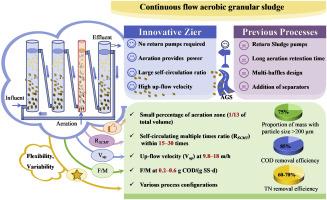A continuous self-circulating granular sludge treatment process for real municipal wastewater: Regulation strategy, exploring granularity and stabilization, and processing performance
IF 9.7
1区 环境科学与生态学
Q1 ENGINEERING, ENVIRONMENTAL
引用次数: 0
Abstract
Existing continuous flow reactors (CFR) utilized for the investigation of aerobic granular sludge (AGS) exhibit structural complexity and suboptimal energy efficiency. An innovative aeration self-circulating CFR (Zier rector) was employed in this study for the cultivation of AGS. The experiment was performed 202 days using real municipal wastewater under varying operating conditions. A hydraulic retention time of 10 h and adequate influent organic matter resulted in a chemical oxygen demand removal efficiency of 85%, an ammonia nitrogen removal efficiency exceeding 92%, and a total nitrogen removal efficiency ranging from 60% to 70%. The particle size increased when the up-flow velocity was maintained between 9.8 and 18 m/h, the self-circulating multiple times ratio was sustained within 12–30 times, and the food-to-microorganism was set within 0.2–0.6 g COD/(g MLSS·d). Ultimately, the mass proportion of sludge with a particle size larger than 0.2 mm was 75%, with 42% exceeding 0.5 mm. The stability of AGS and the treatment efficacy of the Zier process were influenced by the temperature and volume ratio of the nonaerated to the aerated zones. The Zier process demonstrates enhanced advantages and application potential, rendering it a more appealing option for a broader spectrum of water treatment facilities.


真实城市污水连续自循环颗粒污泥处理工艺:调控策略、粒度稳定性探索及处理性能
现有用于好氧颗粒污泥(AGS)研究的连续流反应器(CFR)存在结构复杂性和能量效率不理想的问题。本研究采用新型曝气自循环齐尔反应器(CFR)培养AGS。实验采用真实的城市污水,在不同的操作条件下进行了202天的实验。水力停留时间为10 h,进水有机物充足,化学需氧量去除率为85%,氨氮去除率超过92%,总氮去除率在60% ~ 70%之间。当上流速度维持在9.8 ~ 18 m/h,自循环倍数维持在12 ~ 30次,食物微生物比设定在0.2 ~ 0.6 g COD/(g MLSS·d)时,颗粒尺寸增大。最终粒径大于0.2 mm的污泥质量比例为75%,粒径大于0.5 mm的污泥质量比例为42%。无曝气区与曝气区的体积比、温度对AGS的稳定性和Zier工艺的处理效果均有影响。齐尔工艺展示了增强的优势和应用潜力,使其成为更广泛的水处理设施的更有吸引力的选择。
本文章由计算机程序翻译,如有差异,请以英文原文为准。
求助全文
约1分钟内获得全文
求助全文
来源期刊

Journal of Cleaner Production
环境科学-工程:环境
CiteScore
20.40
自引率
9.00%
发文量
4720
审稿时长
111 days
期刊介绍:
The Journal of Cleaner Production is an international, transdisciplinary journal that addresses and discusses theoretical and practical Cleaner Production, Environmental, and Sustainability issues. It aims to help societies become more sustainable by focusing on the concept of 'Cleaner Production', which aims at preventing waste production and increasing efficiencies in energy, water, resources, and human capital use. The journal serves as a platform for corporations, governments, education institutions, regions, and societies to engage in discussions and research related to Cleaner Production, environmental, and sustainability practices.
 求助内容:
求助内容: 应助结果提醒方式:
应助结果提醒方式:


